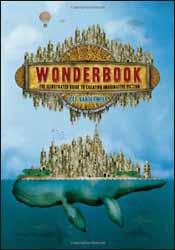|
Click here to return to the main site. Book Review
Writing is a peculiar pastime, four in five of us can read and write and so have the ability to create anything from something as functional as a review to the most sublime sentences which can move us to joy, fear and laughter. Though the major proportion of the population can read and write, only a small proportion go on to actually craft finished stories. Part of the problem is that writing is something you have to practice. I could teach you the basic functions of a piano in five minutes, but that does not mean you can actually play one, it takes dedication and practice and like many human pastimes writing has a history and rules. So, where to start? Well you could do a lot worse than pick up Wonderbook: The Illustrated Guide to Creating Imaginative Fiction (329 pages) by Jeff Vandermeer, author of The Steampunk Bible. There are many books out there with suggestion on how improve your writing, but few provide either the breadth or depth of this tome, this isn’t just a book, it’s a full writing course, with Internet support. Heavily illustrated the book takes you through all aspects of turning out a story. The title may lead you to feel that this is only for those interested in creating science fiction or fantasy and whilst the book is certainly bent towards those genres the information and exercises are pertinent to all forms of creative writing. The book is split into seven lengthy chapters, Inspiration and the Creative Life, The Ecosystem of Story, Beginnings and Endings, Narrative Design, Characterization, Worldbuilding and Revision. Each section covers the main point as well as providing insights from some of the best writers of speculative fiction alive today, which are unique to this book. The illustrations have a multifaceted use, to inspire and instruct, after all a picture can be worth a thousand words by reducing a complex idea to a simply understood graphic. Vandermeer certainly does not want you to use the book passively, writing, by its nature, may be created in isolation, but it is a dynamic activity, so writing challenges are provided to stretch your writing muscles and get you to provide some practical output. There is the final appendix, which is a combination of insights from authors, and another set of exercises. I have a small collection of books on writing and this is by far the best I have read. I hunted for holes, for something which the book was missing, the only thing I could come up with was that it would be a shame if a budding writer of dramatic fiction was put off by the book's fantasy leanings, as this is the closest thing you’re going to find to a well-researched and thorough introduction to successful writing, in all its forms. With the book in hand all you’re going to need is a good idea. This is a book that has turned itself all the way up to eleven. 10 Charles Packer Buy this item online
|
|---|


